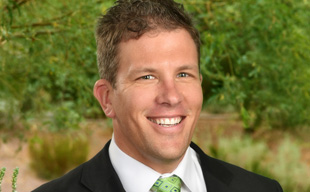By Joyce Coronel
Summit School of Ahwatukee will have a new leader for the 2015-2016 school year, and he’s fired up about challenging students to learn in innovative ways. Mark Bistricky, who has led private schools in Arizona and California, becomes head of school for Summit, effective June 30.
With an undergraduate degree in history and master’s degrees in history and education administration, Bistricky comes to his new role eager to prepare students for the future.
“I think it’s critical for schools like Summit to connect innovation with education and to be forward-looking (and) entrepreneurial,” Bistricky said.

“Business and non-profit leaders say they need workers who can think outside the box, who can create, who can apply imagination, who combine facts and figures and source material from different areas in new ways,” he said.
What’s more, Bistricky notes, the traditional model of education, which consists of digesting information presented and then spitting it back on standardized tests, isn’t going to cut it.
“The problem is that there’s a very low level of learning that takes place in that model. They’re not being challenged to develop the kind of critical-thinking skills (or) the creative skills, the ability to apply what they’ve learned,” Bistricky said.
“I think that Summit already does a tremendous job of equipping the students with those kinds of 21st century skills, and I hope to be able to continue to develop those kinds of programs at the school.”
When asked about the specifics on how innovative learning could best take place, Bistricky gave a description of how students could learn about the desegregation of schools during the 1950s.
In Bistricky’s model, rather than hearing a lecture and receiving work sheets that provided a narrative describing the benchmark case of Brown versus Board of Education, students could learn at a deeper level by taking on the roles of make-believe members of the school board and of parents upset about desegregation and its related issues.
They’d be busy doing research about their character, engaging in dialogue, finding primary sources and sifting through period literature.
There could also be an artistic component where students create a picture or a portrait that symbolizes emotions or feelings or symbols of a particular period in history. They would have an opportunity to stand up in front of the class to make an argument or have the poise to answer questions from other characters in the play.
Bistricky also sees students going beyond classroom walls to learn.
“I think it’s really important for us to be a community school, one that is very connected, and that we’re inviting people in,” Bistricky said. “We want to create a learning community in which all want the same thing: for the child to be challenged.”
The pre-K through eighth-grade independent school boasts low student-teacher ratios and an extensive liberal arts curriculum.
“Independent schools can do innovative things with multi-disciplinary, project-based learning, where students are not just learning material but they’re actually putting it into practice in a real world setting,” Bistricky said.
So how did he catch this innovation bug?
“I first started teaching and ultimately became an administrator when I was living in San Jose, in Silicon Valley, during the technology boom in the early 2000s. So that experience and seeing the innovation and the creativity and the applied learning that was present with all of the technology companies and start-ups, it was a very exciting time for ideas and putting those ideas into action.
“And so I think that helped to form (who) I’ve become,” Bistricky said.
“I want to be an innovative educational leader who’s helping to pioneer new models that will serve our students more effectively in preparing them for a future that doesn’t exist and we can’t entirely predict.”
All this excellence and innovation doesn’t come cheap.
However, through a blend of tuition tax credits, corporate scholarships and financial aid scholarships, “It’s more accessible than you might think,” Bistricky said.
Information: summitschoolaz.org

